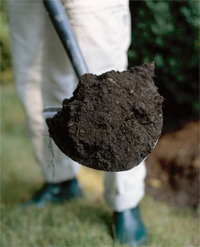Prepare the Ground for Planting
 Most plants prefer a compost and nutrient-enriched soil that is well-drained yet able to retain moisture. Whether your soil is sand or clay based, adding organic matter will improve its texture, nutrient content and water movement patterns.
Most plants prefer a compost and nutrient-enriched soil that is well-drained yet able to retain moisture. Whether your soil is sand or clay based, adding organic matter will improve its texture, nutrient content and water movement patterns.Thorough soil preparation prior to planting is essential for long-term success. This is the only opportunity you will have to work the soil completely. Once plants are established, drainage and aeration cannot be substantially corrected without uprooting the plants.
Test your soil to determine its pH, and adjust if necessary. Most perennials will perform well if the pH falls between 5.5 and 6.5. Acid-loving shrubs including Azaleas, Rhododendrons and evergreens require an acid soil of 5.0-6.0. Roses prefer a slightly acid soil of 6.0-6.5. Annuals, herbs and vegetables mostly prefer a pH between 6.0 and 7.0.
Soil preparation work can be performed any time the soil is not frozen or excessively wet. Dig to a minimum of 12", the deeper the better for root development. A 4-6" layer of organic matter such as well-rotted manure, compost and peat moss should be worked into the soil by digging, spading or rotary tilling. In most cases, thoroughly mix 2 lbs. of an organic blend fertilizer. (Garden Tone, Plant Tone or Bone Meal) or a commercial granular fertilizer (5-10-5, 10-10-10, or superphosphate) at the rate of 2 lbs. per 100 sq. ft. into the top 6" of soil. This will be of benefit in successful plant establishment.